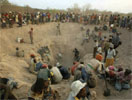
Could Zimbabwe’s diamonds be considered ‘blood diamonds’? According to a recently released report by Human Right’s Watch entitled “Diamonds in the Rough” the answer is yes. The report claims that since last year the Zimbabwean Army, controlled by ZANU-PF, the party of embattled President Robert Mugabe, has used violent and illegal methods to control the diamond mines in the Marange district in eastern Zimbabwe.
On the surface, the army’s decision to retake control of the diamond fields in October 2008 appeared legitimate. The state media depicted the military operation, called No Return, as an attempt to restore order and control to the lawless area. But in reality the operation was simply a way to access a previously untapped source of riches. The revenue gained from selling the diamonds has been used by ZANU-PF to maintain and reinforce their control over the army, which began to slip at the end of last year when soldiers rioted in Harare over their low salaries.
From the start, the army’s actions in Marange have been violent. During Operation No Return the army killed over 400 miners, shooting many of them from helicopters, and then dumping their bodies into unmarked graves. Since taking control of the area, the army has used members of the community as slave labor. Men, women, and children have been forced to work in the diamond fields and one witness stated that “if anyone resists, they risk torture, beatings or even death.” It is an intolerable situation that seems set to continue as the army and ZANU-PF officials continue to profit from selling the diamonds. It is a profit Human Rights Watch argues that could be used, if properly regulated, by Zimbabwe’s unity government to rebuild the country.
Yet Zimbabwe’s diamonds cannot officially, according to the Kimberley Process, be classified as ‘blood diamonds.’ The Kimberley Process was originally created to sever the link between the diamond trade, which was being used by rebel groups to fund their activities, and violent conflicts. Since Zimbabwe’s diamonds are being mined and sold by partners in the unity government – not a rebel group – they do not explicitly meet the Kimberley Process criteria for what constitutes a “blood diamond.” Experts, however, have been publically critical of the narrowness of the Kimberley Process. Talking about Zimbabwean diamonds, Ian Smillie, considered the ‘grandfather’ of the Kimberley Process expressed a strong opinion on the matter: “They are blood diamonds, they have blood all over them,” he said recently. Smillie and some nonprofit groups are lobbying to have Zimbabwe suspended from the Kimberley Process.
A team of representatives from the Kimberley Process is currently in Zimbabwe assessing the situation, and deciding whether or not the government is complying with the group’s standards. If the detailed evidence presented by Human Rights Watch factors into the team’s findings, it will be surprising if they conclude that diamonds from the Marange fields are even remotely “conflict free.” However, it remains to be seen how far parties to the process are willing to go. The Human Rights Watch report lobbies officials to expand the Kimberley Process criteria to include diamonds that fund violence and corruption on the part of government officials as well as non-state actors, but no such movement was made during a recent conference on the Kimberley Process in Namibia where the situation in Zimbabwe topped the agenda.
Rebecca Brocato contributed to this post.
Photo: Diamond mine in Marange. AP via Human Rights Watch

